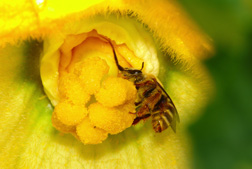This page has been archived and is being provided for reference purposes only. The page is no longer being updated, and therefore, links on the page may be invalid.
|
Read the magazine story to find out more. |
|
|
|
|
Got Pumpkin Pie? Thank A Bee!
By Marcia WoodNovember 18, 2008
Would pumpkin pie be as plentiful without the diligent efforts of pumpkin-pollinating bees? Perhaps not.
Agricultural Research Service (ARS) entomologist James Cane and his colleagues are discovering more about America’s native bees that pollinate pumpkins, other squashes, and gourds. Most of these bees are members of the genus Peponapis or the genus Xenoglossa, according to Cane. He’s based at the agency’s Pollinating Insects Biology, Management and Systematics Research Unit in Logan, Utah.
Investigations such as those that Cane leads provide new details about the extent to which wild bees can help with pollination. Such help is especially needed in view of the ongoing problems faced by the nation’s premier pollinator, the European honey bee, Apis mellifera. Honey bees’ current troubles include the puzzling phenomenon known as colony collapse disorder.
Cane has shown, for the first time, that male Peponapis pruinosa play a surprisingly significant role in pollinating the blossoms of yellow summer squash. In the past, less than 10 percent of pollination has been attributed to male bees.
With both male and female bees on the job, fewer bees overall would be needed, according to Cane. That’s a plus for growers and beekeepers because it suggests that increasingly scarce, in-demand hives of honey bees could be freed up for work elsewhere.
Simple lust may explain the male squash bee's role in pollinating blooms. Unlike male bees that mainly hunt for females at nest sites, P. pruinosa males seek their mates at flowers. As they fly from one blossom to the next, the bees inadvertently carry grains of pollen--trapped in tiny hairs on their bodies--with them, thus helping ensure that plants have the needed pollen.
Read more about this research inthe November/December 2008 issue of Agricultural Research magazine.
ARS is a scientific research agency of the U.S. Department of Agriculture.

